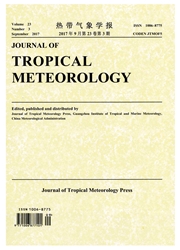

 中文摘要:
中文摘要:
Previous studies emphasize the important role of a 'north-ridge versus south-trough' dipole (affecting the latitudes from 20° to 75° N around the Tibetan Plateau) of anomalous geopotential height ( Z ) in the early-2008 abnormal cryogenic freezing-rain-and-snow events in the southern part of China. The present study intends to extract the leading signal facilitating the dipole based on the numerical outputs of a full Z-linear model for diagnosing the global Z . Using this model built on full primitive equations in spherical-isobaric coordinates, we can further split the anomaly of Z-Zfζ-uβ (representing the Z component not explicitly associated with the Coriolis parameter f and its meridional derivative β ) into 15 components. With the model-output Zfζ-uβ (mainly accounting for the dipole under the geostrophic balance) and Z-Zfζ-uβ matrices as the left and right singular vectors respectively, a maximum covariance analysis (MCA) is performed to extract the significant 2-4-day leading signal carried by the MCA Z-Zfζ-uβ mode in the upstream area of the dipole. This leading signal is mainly attributed to 1) the abnormally strong westerlies centered around the exit region of the Atlantic jet-stream and 2) the corresponding anomalous 950-300 hPa anticyclone to the south of the abnormally strong center of westerlies. The energy of the positive wave center around this jet exit region favors the downstream north-ridge while the energy of the negative wave center associated with the anomalous anticyclone favors the downstream south-trough.
 英文摘要:
英文摘要:
Previous studies emphasize the important role of a "north-ridge versus south-trough" dipole (affecting the latitudes from 20° to 75° N around the Tibetan Plateau) of anomalous geopotential height ( Z ) in the early-2008 abnormal cryogenic freezing-rain-and-snow events in the southern part of China. The present study intends to extract the leading signal facilitating the dipole based on the numerical outputs of a full Z-linear model for diagnosing the global Z . Using this model built on full primitive equations in spherical-isobaric coordinates, we can further split the anomaly of Z-Zfζ-uβ (representing the Z component not explicitly associated with the Coriolis parameter f and its meridional derivative β ) into 15 components. With the model-output Zfζ-uβ (mainly accounting for the dipole under the geostrophic balance) and Z-Zfζ-uβ matrices as the left and right singular vectors respectively, a maximum covariance analysis (MCA) is performed to extract the significant 2-4-day leading signal carried by the MCA Z-Zfζ-uβ mode in the upstream area of the dipole. This leading signal is mainly attributed to 1) the abnormally strong westerlies centered around the exit region of the Atlantic jet-stream and 2) the corresponding anomalous 950-300 hPa anticyclone to the south of the abnormally strong center of westerlies. The energy of the positive wave center around this jet exit region favors the downstream north-ridge while the energy of the negative wave center associated with the anomalous anticyclone favors the downstream south-trough.
 同期刊论文项目
同期刊论文项目
 同项目期刊论文
同项目期刊论文
 Possible linkage between the monsoon trough variability and the tropical cyclone activity over the w
Possible linkage between the monsoon trough variability and the tropical cyclone activity over the w A numerical diagnosis of leading signals facilitating a “north-ridge south-trough” dipole for the ea
A numerical diagnosis of leading signals facilitating a “north-ridge south-trough” dipole for the ea Computing Streamfunction and Velocity Potential in a Limited Domain of Arbitrary Shape.Part I:Theory
Computing Streamfunction and Velocity Potential in a Limited Domain of Arbitrary Shape.Part I:Theory Effects of sea surface temperature,cloud radiative and microphysical processes,and diurnal variation
Effects of sea surface temperature,cloud radiative and microphysical processes,and diurnal variation Moisture Transport over the Arabian Sea Associated with Summer Rainfall over Pakistan in 1994 and 20
Moisture Transport over the Arabian Sea Associated with Summer Rainfall over Pakistan in 1994 and 20 A Numerical Study of the Urban Intensity Effect on Fog Evolution in the Beijing-Tianjin-Hebei Region
A Numerical Study of the Urban Intensity Effect on Fog Evolution in the Beijing-Tianjin-Hebei Region Effects of time-dependent large-scale forcing, solar zenith angle, and sea surface temperature on ti
Effects of time-dependent large-scale forcing, solar zenith angle, and sea surface temperature on ti The Propagation of Wave Packets and Its Relationship with the Subtropical Jet over Southern China in
The Propagation of Wave Packets and Its Relationship with the Subtropical Jet over Southern China in Computing Streamfunction and Velocity Potential in a Limited Domain of Arbitrary Shape.Part II:Numer
Computing Streamfunction and Velocity Potential in a Limited Domain of Arbitrary Shape.Part II:Numer 期刊信息
期刊信息
